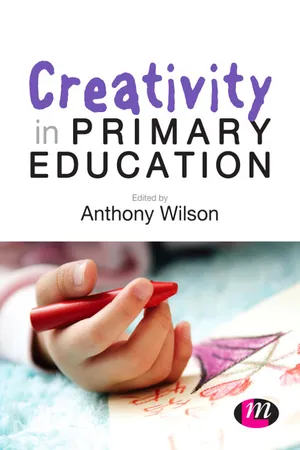
- 272 pages
- English
- ePUB (mobile friendly)
- Available on iOS & Android
Creativity in Primary Education
About This Book
"An alien spaceship crash landed in my playground today"
For one primary school in England, this was not an ordinary day. It was a fabulous day of inspiration, writing, drawing, discovering and learning for the pupils, the staff and the parents. But the best thing of all? The only truly out of the ordinary thing was the alien spaceship.
So how do you make creativity a more everyday part of primary teaching? Teachers and trainees agree that creativity is a fabulous thing. But to get creative approaches into everyday teaching, you need to tackle the question - what is creativity?
This book explores this question in an accessible and practical way. It helps trainees to do more than 'know it when they see it', by helping them to understand the separate and very diverse elements of creativity. The third edition of this popular text retains key material, but it has been updated and revised to include two new chapters on the creative curriculum, along with links throughout to the Standards and the new National Curriculum.
This book will help you enhance your teaching so you and the children in your class can be:
fellow explorers, adventurous discoverers and spontaneous investigators!
Frequently asked questions
Information
Part 1 Setting the Scene
1 Changes in the Landscape for Creativity in Education
Chapter Objectives
- understood that creativity is no longer the preserve of arts education;
- explored how creative teaching focuses on the teacher;
- seen how creativity is critical for individuals to thrive in a rapidly changing world.
- establish a safe and stimulating environment for pupils, rooted in mutual respect;
- have a secure knowledge of the relevant subject(s) and curriculum areas, foster and maintain pupils' interest in the subject, and address misunderstandings;
- promote a love of learning and children's intellectual curiosity;
- fulfil wider professional responsibilities.
Introduction
What has Changed?
Three Waves of Creativity in Education
- The ‘first wave’ of creativity in education was perhaps in the 1960s, codified by Plowden (CACE, 1967), drawing on child-centred philosophy, policy and practice.
- The second wave began in the late 1990s, about ten years after the introduction of the National Curriculum.
- And the third is well under way in the early years of the twenty-first century.
The First Wave: Plowden and beyond
The Second Wave of Creativity in Education
The National Advisory Committee on Creative and Cultural Education Report
Table of contents
- Cover
- Half Title
- Acknowledgements
- Title Page
- Copyright Page
- Contents
- Contributors
- Acknowledgements
- Introduction
- Part 1 Setting the Scene
- 1 Changes in the Landscape for Creativity in Education
- 2 The Art of the Possible: Creative Principled Leadership
- 3 Creative Teachers and Creative Teaching
- 4 Play and Playfulness in the Early Years Foundation Stage
- 5 Creativity and Spiritual, Moral, Social and Cultural Development
- 6 The Importance of Informal Learning to Children's Creative Education
- Part 2 Creativity in the Core Curriculum
- 7 Creativity and Literacy
- 8 Creative Mathematics
- 9 What is Creativity in Science Education?
- Part 3 Creativity in the Foundation Curriculum
- 10 Thinking about Creativity: Developing Ideas and Making Things Happen
- 11 Creativity and Primary Art and Design Education
- 12 What has Creativity Got to do with Citizenship Education?
- 13 Creativity in Primary Design and Technology
- 14 Creative Primary Geography
- 15 Creativity in Primary History
- 16 Creativity in the Music Curriculum
- 17 Children, Creativity and Physical Education
- Index